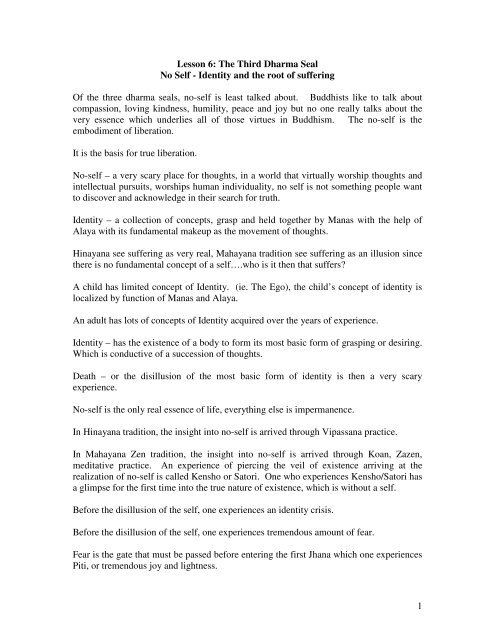Dharma Seal No Self.pdf - Regina Zen Sangha
Dharma Seal No Self.pdf - Regina Zen Sangha
Dharma Seal No Self.pdf - Regina Zen Sangha
You also want an ePaper? Increase the reach of your titles
YUMPU automatically turns print PDFs into web optimized ePapers that Google loves.
Lesson 6: The Third <strong>Dharma</strong> <strong>Seal</strong><br />
<strong>No</strong> <strong>Self</strong> - Identity and the root of suffering<br />
Of the three dharma seals, no-self is least talked about. Buddhists like to talk about<br />
compassion, loving kindness, humility, peace and joy but no one really talks about the<br />
very essence which underlies all of those virtues in Buddhism. The no-self is the<br />
embodiment of liberation.<br />
It is the basis for true liberation.<br />
<strong>No</strong>-self – a very scary place for thoughts, in a world that virtually worship thoughts and<br />
intellectual pursuits, worships human individuality, no self is not something people want<br />
to discover and acknowledge in their search for truth.<br />
Identity – a collection of concepts, grasp and held together by Manas with the help of<br />
Alaya with its fundamental makeup as the movement of thoughts.<br />
Hinayana see suffering as very real, Mahayana tradition see suffering as an illusion since<br />
there is no fundamental concept of a self….who is it then that suffers?<br />
A child has limited concept of Identity. (ie. The Ego), the child’s concept of identity is<br />
localized by function of Manas and Alaya.<br />
An adult has lots of concepts of Identity acquired over the years of experience.<br />
Identity – has the existence of a body to form its most basic form of grasping or desiring.<br />
Which is conductive of a succession of thoughts.<br />
Death – or the disillusion of the most basic form of identity is then a very scary<br />
experience.<br />
<strong>No</strong>-self is the only real essence of life, everything else is impermanence.<br />
In Hinayana tradition, the insight into no-self is arrived through Vipassana practice.<br />
In Mahayana <strong>Zen</strong> tradition, the insight into no-self is arrived through Koan, Zazen,<br />
meditative practice. An experience of piercing the veil of existence arriving at the<br />
realization of no-self is called Kensho or Satori. One who experiences Kensho/Satori has<br />
a glimpse for the first time into the true nature of existence, which is without a self.<br />
Before the disillusion of the self, one experiences an identity crisis.<br />
Before the disillusion of the self, one experiences tremendous amount of fear.<br />
Fear is the gate that must be passed before entering the first Jhana which one experiences<br />
Piti, or tremendous joy and lightness.<br />
1
Suffering is a condition associated with an existence of the self which has no real<br />
existence but is dependent on eight factors of consciousness.<br />
The insight of no-self cannot be communicated, but only through personal practice in<br />
gaining insight into nature of existence.<br />
To arrive at the insight of no self, we must question and observe the ever changing nature<br />
of what is called a “self”.<br />
A body – what we fundamental identify with being of our “self” is ever changing.<br />
A name – it is rarely unique to anyone. It too changes as we wish it. It is also a<br />
collection of several words together to form a name. It was given to us after we were<br />
born. If we weren’t given a name then, who then are we?<br />
Being male or female – this too with recent medical advances could also be changed, and<br />
is tied in with the function of a body.<br />
Feelings – well this changes all the time.<br />
Collection of traits – is interchangeable depending on whether a person wishes it to be<br />
changed and apply themself to doing so.<br />
Who is this “I” then when we refer to ourself? Who is this “I” that the thought constantly<br />
revolve its activities around? Who is this “I” that we constantly reference to in our<br />
language, in our actions, in our thoughts?<br />
The only way we can get to the root of “I” is to observe in our consciousness, in our<br />
experience, that which does not change.<br />
The Buddha is a scientist of consciousness. Determined to find out for himself the<br />
nature of identity, he sat for 49 days in silent meditation to observe his own<br />
consciousness to find out the true nature of the self.<br />
Without judgment, without a label on anything to hinder his observation, he arrived that<br />
the true nature of self.<br />
<strong>No</strong> <strong>Self</strong> is the absolute reality of all forms in nature, including all of which that forms our<br />
existence and experience.<br />
When we experience something, the experience itself is observed without labeling and<br />
referencing to another “label” called “I”, which in essence are nothing more but the<br />
movements of constant thought stream.<br />
2
There is more to life than thinking. The problem is…..we know no other reality other<br />
than that which has a voice of thinking constantly chattering away in our consciousness.<br />
<strong>Zen</strong> is nothing more than a practice of meditation to calm this incessant noise down and<br />
experiencing the absolute nature of reality without its filters. This is the greatest<br />
liberation of it all. To wake up from the dream created by mental filters of the mind, to<br />
free yourself from your mind, the true intuitive experience of which will be that of true<br />
liberation.<br />
<strong>No</strong> self then is not a label, a concept, but a reality that can be accessed by lifting the veil<br />
of the mind from the absolute nature of experience.<br />
3


